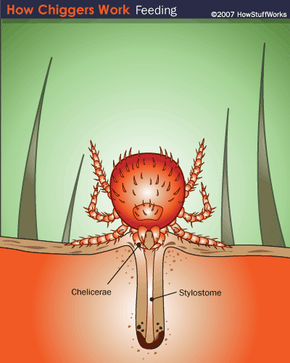Chigger Bites
Scientists have found chiggers on snakes, turtles, birds and a wide variety of animals, but people aren't their preferred hosts. Many of the animals chiggers feed on don't react to their bites, so there's no risk of being brushed or scratched off before its meal is over. This is important because a chigger that doesn't finish a meal doesn't usually start another one. Instead, it dies before molting, which is usually what happens when a chigger bites a person. People usually start to itch within a few hours and often scratch the feeding chiggers away. A hot shower with plenty of soap will also kill chiggers, so hygiene practices in most of the world are likely to remove and kill chiggers before they finish eating.
Like ticks, fleas and mosquitoes, chiggers have specialized mouthparts that help them retrieve food from their hosts. A chigger uses two specialized mouthparts called chelicerae to make a hole in its host's skin. It then injects some of its saliva into the wound. The saliva contains digestive enzymes that break down cell walls. The partially digested cells and their contents become a slurry that the chigger ingests.
Advertisement
Unlike many other parasitic bugs, chiggers don't have needlelike, piercing mouthparts. Instead, they use an interesting accomplice -- the host's own skin. The same salivary secretions that break down cells also cause the surrounding tissue to harden. This creates a strawlike tube called a stylostome. The longer the chigger feeds, the longer the stylostome becomes, and the deeper it penetrates into the skin.
The intense itching that chigger bites cause comes from two sources. One is an allergic reaction to the chiggers' saliva. In some people, this reaction is extreme, leading to large sores or hives. In most, it simply causes a small, red, itchy bump. The other source of itching is the stylostome itself. It causes irritation and discomfort until the body's immune and lymphatic systems dissolve it and carry it away. If the chigger fed for a long time and the stylostome extends deep into the skin, this process can take quite a while.
Many home remedies for chigger bites, like painting the bite with nail polish, involve the idea of smothering an embedded chigger. But by the time you notice the bite, you've often brushed or scratched away the chigger already. The reason nail polish makes some people's bites feel better is that it seals the bite from air. Over-the-counter creams that relieve itching often do a better job of making the bites feel better. It's also a good idea to apply an antiseptic, especially if you've scratched the bite extensively -- too much scratching can lead to a secondary infection. If you're bitten, don't be tempted to try home remedies involving toxic substances, and don't try to remove the stylostome -- either could cause secondary infections or other injuries.
In a lot of ways, preventing chigger bites is easier than treating them. We'll look at how to keep chiggers off your skin in the next section.
